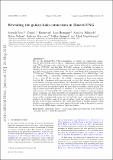| dc.contributor.author | Bose, Sownak | |
| dc.contributor.author | Eisenstein, Daniel J | |
| dc.contributor.author | Hernquist, Lars | |
| dc.contributor.author | Pillepich, Annalisa | |
| dc.contributor.author | Nelson, Dylan | |
| dc.contributor.author | Marinacci, Federico | |
| dc.contributor.author | Springel, Volker | |
| dc.contributor.author | Vogelsberger, Mark | |
| dc.date.accessioned | 2022-07-21T21:32:47Z | |
| dc.date.available | 2021-09-20T18:23:01Z | |
| dc.date.available | 2022-07-21T21:32:47Z | |
| dc.date.issued | 2019 | |
| dc.identifier.uri | https://hdl.handle.net/1721.1/132556.2 | |
| dc.description.abstract | © 2019 The Author(s) Published by Oxford University Press on behalf of the Royal Astronomical Society We use the IllustrisTNG (TNG) simulations to explore the galaxy-halo connection as inferred from state-of-the-art cosmological, magnetohydrodynamical simulations. With the high-mass resolution and large volume achieved by combining the 100 Mpc (TNG100) and 300 Mpc (TNG300) volumes, we establish the mean occupancy of central and satellite galaxies and their dependence on the properties of the dark matter haloes hosting them. We derive best-fitting HOD parameters from TNG100 and TNG300 for target galaxy number densities of n¯ g = 0.032 and n¯ g = 0.016 h3 Mpc−3, respectively, corresponding to a minimum galaxy stellar mass of M* ∼ 1.9 × 109 and M* ∼ 3.5 × 109 M☉, respectively, in hosts more massive than 1011 M☉. Consistent with previous work, we find that haloes located in dense environments, with low concentrations, later formation times, and high angular momenta are richest in their satellite population. At low mass, highly concentrated haloes and those located in overdense regions are more likely to contain a central galaxy. The degree of environmental dependence is sensitive to the definition adopted for the physical boundary of the host halo. We examine the extent to which correlations between galaxy occupancy and halo properties are independent and demonstrate that HODs predicted by halo mass and present-day concentration capture the qualitative dependence on the remaining halo properties. At fixed halo mass, concentration is a strong predictor of the stellar mass of the central galaxy, which may play a defining role in the fate of the satellite population. The radial distribution of satellite galaxies, which exhibits a universal form across a wide range of host halo mass, is described accurately by the best-fitting NFW density profile of their host haloes. | en_US |
| dc.language.iso | en | |
| dc.publisher | Oxford University Press (OUP) | en_US |
| dc.relation.isversionof | 10.1093/MNRAS/STZ2546 | en_US |
| dc.rights | Creative Commons Attribution-Noncommercial-Share Alike | en_US |
| dc.rights.uri | http://creativecommons.org/licenses/by-nc-sa/4.0/ | en_US |
| dc.source | arXiv | en_US |
| dc.title | Revealing the galaxy–halo connection in IllustrisTNG | en_US |
| dc.type | Article | en_US |
| dc.contributor.department | MIT Kavli Institute for Astrophysics and Space Research | en_US |
| dc.contributor.department | Massachusetts Institute of Technology. Department of Physics | en_US |
| dc.relation.journal | Monthly Notices of the Royal Astronomical Society | en_US |
| dc.eprint.version | Original manuscript | en_US |
| dc.type.uri | http://purl.org/eprint/type/JournalArticle | en_US |
| eprint.status | http://purl.org/eprint/status/NonPeerReviewed | en_US |
| dc.date.updated | 2020-11-16T17:59:16Z | |
| dspace.orderedauthors | Bose, S; Eisenstein, DJ; Hernquist, L; Pillepich, A; Nelson, D; Marinacci, F; Springel, V; Vogelsberger, M | en_US |
| dspace.date.submission | 2020-11-16T17:59:21Z | |
| mit.journal.volume | 490 | en_US |
| mit.journal.issue | 4 | en_US |
| mit.license | OPEN_ACCESS_POLICY | |
| mit.metadata.status | Publication Information Needed | en_US |
